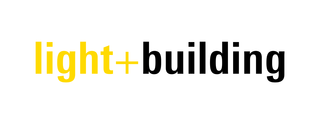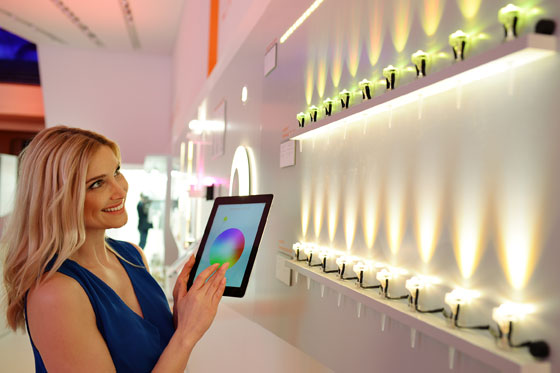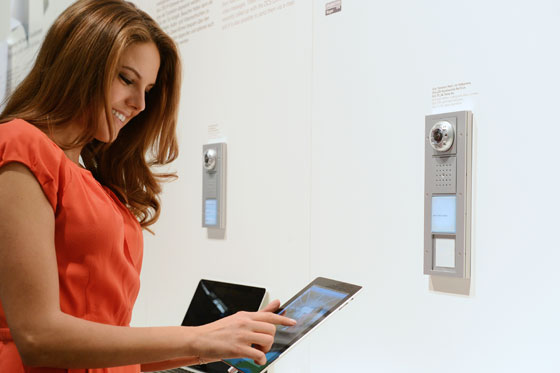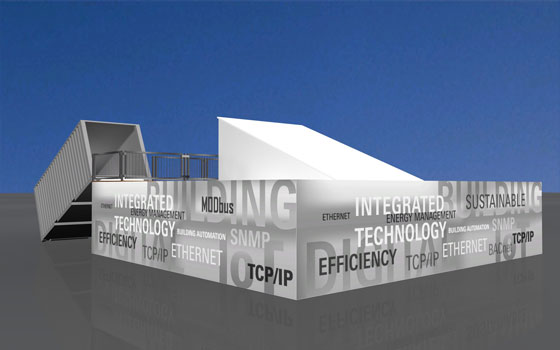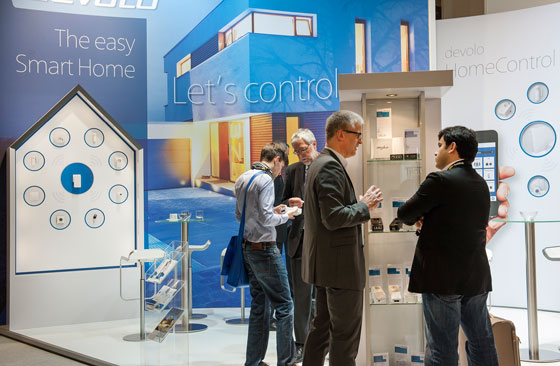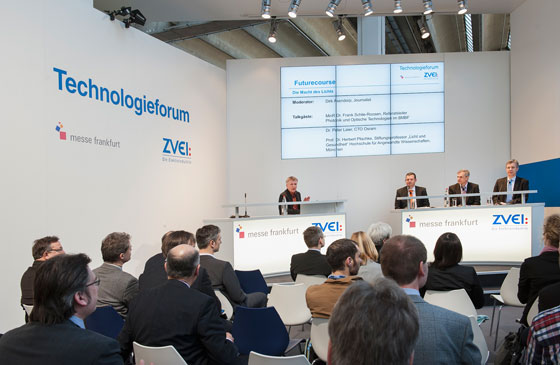Light + Building 2016: Smart homes become a reality
Text by Light + Building
Frankfurt am Main, Germany
01.03.16
There are few words that have impacted on the language of technology so massively over the past two decades as the notion of 'smart'. The things it covers begin with the 'smart phone' and end up with the 'smart watch' and the 'smart grid'. Everyone is talking about them. In building services engineering, interest now centres, after the 'smart meter', on the 'smart home'. And there are now more and more practically usable and market-ready concepts appearing on the market.
At the beginning of August, the Federal German Ministry of Economics published its roadmap for the introduction of so-called 'smart meters'. Work is currently being undertaken on a proposed law covering the universal introduction of intelligent electricity meters and measuring systems. The old disc-type induction meters (Ferraris meters) are set to disappear gradually, as from 2020, even in private houses. In this way, the 'smart grid' – an important element of the energy revolution – is due to become a reality. From the consumer's point of view this shift is, however, just one aspect of a much broader set of developments, which supposedly end up with the 'smart home'. The advantages of a smart home are, essentially, the high degree of energy efficiency and the gain in comfort and convenience for the inhabitants.
The path to the 'smart home'
'Adept', 'clever' and 'shrewd' are just some synonyms in the thesaurus for the word 'smart'. In the context of technical equipment and systems, the concept of 'intelligence' is often invoked. By this, people generally mean electronic or IT-based control technology, which enables additional functions to be performed. A typical example is the smartphone, which offers numerous functions that no longer have anything to do with the original function – viz. telephoning. All these developments have become possible because the cost of electronic and IT components has fallen rapidly over the last few decades. Sensor technology has also benefited from this trend and has now become both significantly cheaper and significantly more powerful and efficient.
Intelligence spreads to more and more appliances
This development is also continuing to find its way into domestic dwellings. Heating technology led the field in this area. Central heating systems in domestic dwellings have been equipped with control technology ever since the 1970s, regulating, for example, the flow temperature in the heating circuit depending on the temperature outside. With the introduction of digital technology, control systems have become more and more efficient and have offered ever greater additional functionality. Today, control mechanisms are available for practically all elements in any system. One of the biggest challenges in recent years has been not only to make the individual parts of the system 'smart', but to get them to be able to – and be obliged to - work together. In the 'smart home', we can so arrange things that the window blinds, the air-conditioning and the heating in the rooms are dependent on the weather and interdependent on each other. It is precisely these superordinate functions that turn 'domestic dwellings' into 'smart homes'. The kind of functionality, which this makes possible, pertains to features such as energy efficiency, convenience and comfort.
Greater energy efficiency with the 'smart home'
With regard to the introduction of the 'smart meter', energy providers can now offer new models, where the cost of electricity varies, depending on the time of day. An automated system in the 'smart home' can switch on the washing machine or the heat pump, at the exact time that the electricity is cheapest. Demand-led heating systems or lighting control systems that switch the lights on only when there is someone present in the room are all possible additional functions, which contribute to higher levels of energy efficiency. For the inhabitants, functions that increase convenience and comfort are often even more important. A lighting control system which switches over, at the touch of a button, to a pre-determined lighting scenario for dining, reading or watching TV is a typical example of this. And a heating regulation system, that can be controlled remotely via the internet makes things more convenient and comfortable – if you can warm up your home while you are still on the way there.
Linking all the systems in a network
So that the many different intelligent systems in a domestic dwelling can coalesce to qualify as a 'smart home', the equipment and systems installed in the house must be able to work together. In the past, this has been one of the greatest obstacles on the path to the smart home. Whilst there were numerous intelligent controls in the building and in the equipment and appliances, they were only rarely capable of working together. Here too, computer technology provides the best example. Open interfaces, such as are widely known in the world of PCs, are being increasingly introduced into building automation systems.
Another issue is the simplicity and intuitive nature of the user interface in such automated buildings. Because of the PC and the smartphone, users are now accustomed to intuitive, user-friendly interfaces. Building automation systems for use in the private sphere will need to measure up to the same standards.
Light + Building showcases innovations for the 'smart home'
At Light + Building numerous exhibitors will be presenting their latest solutions for the 'smart home'.
They will be showcasing systems for creating networks and digitised systems, both for renovation work in existing buildings and for new builds. The 'smart home' is also a major theme running through the complementary programme at Light + Building.
Trends and sector knowledge at the complementary programme
The Digital Building exhibition reflects the motto of Light + Building, ‘Where modern spaces come to life: digital – individual – networked’, and illustrates digitalisation in buildings using a variety of future-oriented technologies revolving around the networking of individual components and their systematic interaction. The overall focus of the special show is on functional buildings. ‘Digital Building’ brings a variety of automation technologies to life as a whole. Moreover, the exhibition shows the opportunities and new options offered by digitalisation in the field of building-services technology with a variety of sub-systems being networked to show the interoperability of technologies. A highlight of the exhibition is the standardised Ethernet / BACnet / TCP-IP solutions. The various bus technologies available on the building market should be used as far as possible as a central means of transmission, e.g., Ethernet, after conversion to the BACnet-IP protocol via a physically linked field / automation bus network. This networking and automation technology has the advantage of being extremely flexible. Thus, all elements installed in a building, e.g., fire alarm, lifts, blinds, lighting, video surveillance, etc., can be controlled and integrated as required. Digital networking not only permits components to be used as necessary and linked flexibly; it also means the building-automation network can be extended without difficulty, communication and surveillance centralised, and operating costs reduced – all of which represent major benefits for the user.
The ZVEH E-House of the German Central Association of Electrical and Information Technology Contractors (Zentralverband der Deutschen Elektro- und Informationstechnischen Handwerke) picks up on this theme and demonstrates what networked building-services technology and intelligent energy management looks like from the end consumer’s point of view. This ‘energy-saving power plant’ provides a real view of how the so-called Energy Turnaround works in practice and how it is already possible, today, for energy efficiency and increased comfort, convenience and security to go hand in hand. In 2016 the E-House takes as its motto ‘energy efficiency, convenience and security – intelligent solutions from the professionals’ and can be found in Hall 8.0 Stand J60.
The German Electrical and Electronic Manufacturers' Association (ZVEI) provides an overview of the possibilities of smart lighting with its sector initiative ‘licht.de’ in Hall 3.0 Stand C80. For the first time, members of the ZVEI are joining forces to present the theme of ‘Throughout the day with smart lighting’ for various aspects of everyday life in form of a guided tour. Private, public and workplace lighting environments are displayed in which lighting can be adjusted to cater for the individual needs of people and the requirements of the user. It emphasises the possibilities created by the networking of lighting applications to increase energy efficiency and lighting comfort.
In a series of seminars and lectures, Building Performance offers trade visitors the opportunity to find out more about all aspects of lighting and integrated building services technology. Lectures to accompany the trade fair, specialist forums and seminars with renowned experts in the field will explore current developments, innovations and technological solutions. The Building Performance programme includes the German Energy Consultants’ Day 2016, IALD Lighting Perspectives, IEECB – Improving Energy Efficiency in Commercial Building Conference 2016, the Technology Forum organised by the Association of the German Electrical and Electronics Industry (ZVEI) and Messe Frankfurt, efficient.buildings.live@L + B, Technical Monitoring as tool for the operator, the Architecture Forum – Light and Lighting, Smart Energy and Intelligent Building Automation, The Information Day for Environmentally Friendly Buildings in the Asia-Pacific Region, Light Planning and Interior Architecture, Lighting at its Quality Characteristics.
At Light + Building 2016 the Futurecourse debating forum brings together representatives from politics, commerce and industry at the heart of the world's largest trade fair for lighting and building services technology. Over the four days of the trade fair, two or three guests at a time will discuss current issues in a chaired debate. The public will also have the opportunity to ask questions at the end. Futurecourse is part of the Technology Forum which is organised jointly by Messe Frankfurt and the Association of the German Electrical and Electronics Industry (Zentralverband Elektrotechnik- und Elektronikindustrie e.V. - ZVEI) and is aimed at encouraging professional dialogue between exhibitors and visitors. This podium discussion takes place in Hall 8.0 Stand C41.
